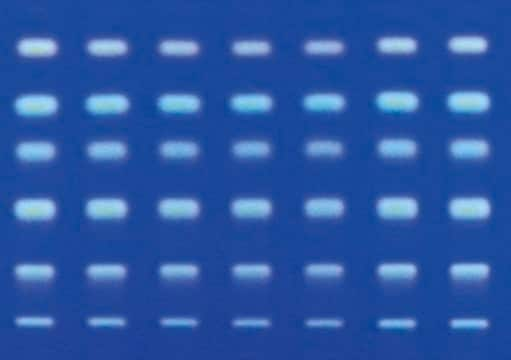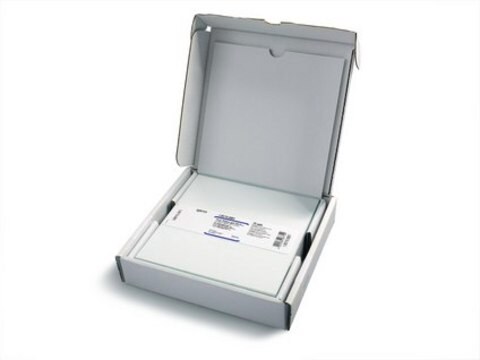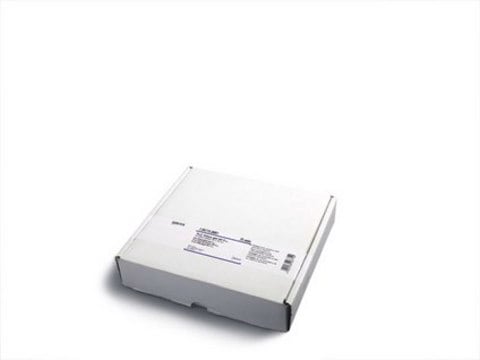1.05914
HPTLC plates, Silica gel 60 RP-18
pkg of 25 plates, plate L × W 20 cm × 10 cm, glass support
Synonyme(s) :
High-performance thin-layer chromatography plates
About This Item
Produits recommandés
Matériaux
glass support
silica gel 60 matrix
Niveau de qualité
Caractéristiques
binder Organic Polymer
fluorescent indicator: no
Conditionnement
pkg of 25 plates
Technique(s)
thin layer chromatography (TLC): suitable
Épaisseur de la couche
200 μm
Plaque/Plateau, L × l
20 cm × 10 cm
Taille des particules
5-6 μm
Dimension de pores
60 Å medium pore diameter
Température de stockage
2-30°C
Description générale
Application
- Densitometric HPTLC method for qualitative, quantitative analysis and stability study of Coenzyme Q10 in pharmaceutical formulations utilizing normal and reversed-phase silica gel plates.: This study presents a high-performance thin-layer chromatography (HPTLC) method for analyzing Coenzyme Q10 in pharmaceutical formulations. The method employs both normal and reversed-phase silica gel plates to achieve qualitative and quantitative analysis, as well as stability testing of Coenzyme Q10 (Abdel-Kader et al., 2016).
- Simultaneous Quantification of Gymnemic Acid as Gymnemagenin and Charantin as β-Sitosterol Using Validated HPTLC Densitometric Method.: This research develops a validated HPTLC densitometric method for the simultaneous quantification of gymnemic acid and charantin in herbal formulations. The method utilizes silica gel 60 F₂₅₄ plates for effective separation and quantification (Ahamad et al., 2015).
- Estimation of catechin in Ayurvedic oil formulations containing Acacia catechu.: The study estimates the content of catechin in Ayurvedic oil formulations using HPTLC. Silica gel 60 F₂₅₄ plates are employed to ensure accurate quantification of catechin in these formulations (Dubey et al., 2009).
- Development and validation of HPTLC method for estimation of tacrolimus in formulations.: This paper details the development and validation of an HPTLC method for estimating tacrolimus in pharmaceutical formulations. The method uses silica gel 60 F₂₅₄ plates for efficient separation and quantification of tacrolimus (Borhade et al., 2009).
- Estimation of berberine in ayurvedic formulations containing Berberis aristata.: The research focuses on the estimation of berberine in Ayurvedic formulations. Using HPTLC with silica gel 60 F₂₅₄ plates, the study provides a reliable method for berberine quantification (Rout et al., 2008).
Liaison
Remarque sur l'analyse
Pore volume (N₂-isotherm): 0.74 - 0.84 ml/g
d 50 (laser diffraction, size distribution): 5 - 7 µm
Layer thickness: 150 - 200 µm
Deviation of layer thickness per plate: ≤ 35 µm
Chromatographic testings:
A) Cholesterin test
hRf-values
- cholesterin, cholesterin test:
13 - 23
B) Steroid test
- methyltestosterone, steroid test: 20 - 35
- Reichstein S, steroid test: 50 - 65
- hydrocortisone, steroid test: 65 - 80
Typical value determined on an activated plate (120°C, 15 min)
Eluent a) aceton/ water (95/5 v/v)
Eluent b) acetonitrile/ water (70/30 v/v)
Produit(s) apparenté(s)
Certificats d'analyse (COA)
Recherchez un Certificats d'analyse (COA) en saisissant le numéro de lot du produit. Les numéros de lot figurent sur l'étiquette du produit après les mots "Lot" ou "Batch".
Déjà en possession de ce produit ?
Retrouvez la documentation relative aux produits que vous avez récemment achetés dans la Bibliothèque de documents.
Les clients ont également consulté
Notre équipe de scientifiques dispose d'une expérience dans tous les secteurs de la recherche, notamment en sciences de la vie, science des matériaux, synthèse chimique, chromatographie, analyse et dans de nombreux autres domaines..
Contacter notre Service technique




